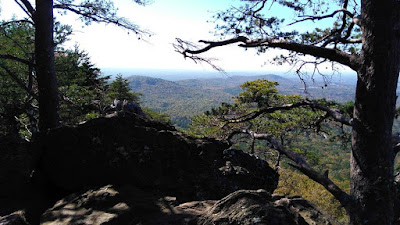This park preserves and
interprets a brief moment in our nation’s history – a Revolutionary War battle
that took about an hour, but became a pivotal link in the chain of events that
led to winning the war and founding our country. Working at Kings Mountain
immersed us in the history of the era and the often-overlooked southern
campaign of the war.
 |
Bill leading a guided
battlefield walk
|
 |
| Barbara taught students how to make candles. |
 |
| Bill participated in black powder weapons demonstrations. |
While working at Kings Mountain,
we also got the opportunity to explore the region. Visiting other Revolutionary
War sites put the Battle at Kings Mountain
into context and gave us a chance to observe the different ways the parks
interpret history.
Most visitors to Kings Mountain
National Military
Park wanted to learn
about the history, but some people wanted to hike. We hiked pretty much all the
local trails, so we were able to give a good description of the options. Here’s
the view from Kings Pinnacle, which may be the most scenic hike near Kings Mountain.
The local hikes were good,
but our favorite thing to do on our days off was to drive over an hour to the
edge of the Blue Ridge Mountains and hike. We
got to see some beautiful places in the Carolinas.
Also we attended a Community Bible Study class. Barbara’s been involved with CBS for over 20 years, so was glad to hear of a new evening co-ed class in the area. We got to study the Bible weekly and still be available to work weekends. We pray for special blessings to our core leaders and the Servants Team as they continue their first year as a CBS class!
One thing we learned while
working at Kings Mountain was a quote by Maya Angelou
that Ranger Adrian shared with us.
Being a volunteer with the
interpretive rangers brought us face to face with visitors. We shared the
history, but tried most of all to make them feel good about their experience at
Kings Mountain. Like one time when a couple
drove all the way from Florida just to see Kings Mountain,
but were disappointed that the monuments weren’t handicap accessible. Bill
wanted their time to be memorable, so spent extra time with them and pulled out
the guns giving them a private weapons talk.
It amazed us to see the
varieties of reasons people walked through the door. Some came for history,
some for a walk in the woods, some to visit yet another National Park, some as
it is their regular place to hang out, some to buy a senior pass, some because
they had ancestors in the battle, and some didn’t know why they came, but saw
the sign and thought they ought to check it out. Every once in a while we would
hear their stories.
 |
| Photographer Bart Smith hiked almost all the National Scenic & Historic Trails (28,000+ miles). |
 |
| Clyde, a regular visitor, is writing a book about Kings Mountain. |
 |
We even met a bear who
visits National Parks.
|
We got to know the rangers a
bit, too, and appreciate all they did to help us out. They took us out to eat
on one of our last nights. And it felt like a fitting end that on our last full
night we heard the Kings
Mountain story around a
campfire.





































